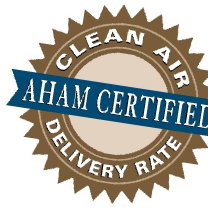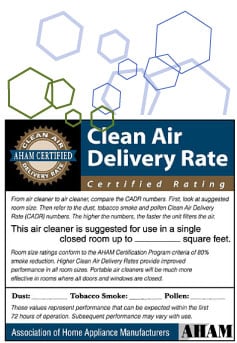 On many different brands of air purifiers you will find the Association of Home Appliance Manufacturers (AHAM) certified Clean Air Delivery Rate (CADR) logo, a test/certification that is recognized by the American National Standards Institute (ANSI). The CADR is one of the criteria used Consumer Union in rating air purifiers for their Consumer Reports publication, and a complete list of AHAM certified manufacturers can be found on their website. There are no surprises when it comes to this list unless we note who is absent. Some of the most prominent air purifier manufacturers are not members, nor do they submit their products to AHAM testing. In trying to better understand who is absent and why, it will be helpful to explain CADR, what limitations there are with the CADR, and AHAM’s role in the air purifier industry.
On many different brands of air purifiers you will find the Association of Home Appliance Manufacturers (AHAM) certified Clean Air Delivery Rate (CADR) logo, a test/certification that is recognized by the American National Standards Institute (ANSI). The CADR is one of the criteria used Consumer Union in rating air purifiers for their Consumer Reports publication, and a complete list of AHAM certified manufacturers can be found on their website. There are no surprises when it comes to this list unless we note who is absent. Some of the most prominent air purifier manufacturers are not members, nor do they submit their products to AHAM testing. In trying to better understand who is absent and why, it will be helpful to explain CADR, what limitations there are with the CADR, and AHAM’s role in the air purifier industry.
So What Is the Clean Air Delivery Rate (CADR)?
Developed in the early 1980’s CADR is “the rate of contaminant reduction in the test chamber when the unit is turned on, minus the rate of natural decay when the unit is not running, multiplied by the volume of the test chamber as measured in cubic feet.” More simply put, it is a measure of the removal of specific particulates in a controlled environment. The ability to remove dust, pollen, and smoke particles ranging from 0.10 to 11 microns, from the air, is measured. So what information do the results tell us?
- Size range of the particle removed
- Percentages of particles are removed
- Volume of air actually moving through the system
What Are the Components of the CADR Test?
 There are a few components of the test to keep in mind, size of the space, duration of the test period, size of the particles measured, and what the resulting CADR test results demonstrate. For starters, the size of the test space is 1008 cubic feet (roughly an 11′ x 11′ room with 8′ ceiling). This is roughly the equivalent to a fairly small bedroom in most homes. Second, of the three particle types tested, the length of the testing period ranges from 10 minutes for pollen to 20 minutes for smoke and dust. Third, for each test, the size of particles tested falls into these three ranges.
There are a few components of the test to keep in mind, size of the space, duration of the test period, size of the particles measured, and what the resulting CADR test results demonstrate. For starters, the size of the test space is 1008 cubic feet (roughly an 11′ x 11′ room with 8′ ceiling). This is roughly the equivalent to a fairly small bedroom in most homes. Second, of the three particle types tested, the length of the testing period ranges from 10 minutes for pollen to 20 minutes for smoke and dust. Third, for each test, the size of particles tested falls into these three ranges.
- Cigarette Smoke: 0.10 – 1.0 microns in size
- Fine Dust: 0.5 – 3.0 microns in size
- Pollen: 5.0 – 11.0 microns in size
Lastly, the percentages are then converted to numerical rates that range from 0 – 450 for dust and pollen, 0 – 400 for smoke.
But What Does All This Mean For Air Purifier Efficiency?
In terms of the test, it does exactly what it was meant to do, gives you comparison numbers to see how individual air purifiers perform in removing said particulate, from the air, in a controlled space. The CADR ratings demonstrate not just how much air is cleaned nor just what percentages of particles are removed, but the overall performance of the filtration system when both factors are examined. While this standard can be helpful, particularly when trying to determine how large of an air purifier you need for your specific situation, there are several limitations to this test.
Problems With The Clean Air Delivery Rate Test
![]() Ozone – Let’s start with what AHAM itself states as a limitation of the test. “The ability of the air cleaner to reduce gases, odors or microbiological components, or the sound and ozone emissions levels of the product are outside the scope.” This is a problem, and it should only take a moment to realize why. Many people are looking for an air cleaner want one that not only tackles things like pollen and dust but also odors, chemical vapors, and VOCs (Volatile Organic Compounds). More importantly, this test doesn’t factor in ozone emissions.
Ozone – Let’s start with what AHAM itself states as a limitation of the test. “The ability of the air cleaner to reduce gases, odors or microbiological components, or the sound and ozone emissions levels of the product are outside the scope.” This is a problem, and it should only take a moment to realize why. Many people are looking for an air cleaner want one that not only tackles things like pollen and dust but also odors, chemical vapors, and VOCs (Volatile Organic Compounds). More importantly, this test doesn’t factor in ozone emissions.
That’s HUGE! Ozone affects anyone at higher concentrations, but or people with asthma or COPD, ozone is particularly nasty lung irritant. So while the EPA actually directs people to consult AHAM and the CADR, it spends the rest of this webpage talking about how air purifiers that produce ozone are particularly harmful for your health. Yes, it is a bit of a contradiction, but it highlights an important flaw in testing. Many of the older ozone-producing “air purifiers” were well suited to pass CADR testing with flying colors, giving you a false sense of security while actually being potentially detrimental to your health. Over time, ozone generating units have fallen out of favor and out of production for residential use. Ozone emission standards have also been tightened, but this hole in the CADR test remains a significant one.
![]() Chemical Vapors & VOCs – As mentioned by AHAM, the CADR does not take into account factors such as the ability to neutralize and/or remove VOCs. Many of the air purifiers that are designed to specifically remove these pollutants face an uphill battle with the CADR. The most commonly employed technology to remove VOCs, odors, and chemical vapors is activated carbon. Ranging from just a couple pounds to nearly thirty pounds of granulated carbon in some air purifier filters, this substance adsorbs chemicals, odors, and smoke. Pushing air through a 3″ thick, 25 lb. carbon filter does not bode well for a test favoring units that move air quickly in a ten to twenty minute time period. Besides, key to activated carbon working effectively is dwell time (amount of time air takes to pass through carbon). The longer the dwell time, the more effective the carbon is at removing these types of pollutants.
Chemical Vapors & VOCs – As mentioned by AHAM, the CADR does not take into account factors such as the ability to neutralize and/or remove VOCs. Many of the air purifiers that are designed to specifically remove these pollutants face an uphill battle with the CADR. The most commonly employed technology to remove VOCs, odors, and chemical vapors is activated carbon. Ranging from just a couple pounds to nearly thirty pounds of granulated carbon in some air purifier filters, this substance adsorbs chemicals, odors, and smoke. Pushing air through a 3″ thick, 25 lb. carbon filter does not bode well for a test favoring units that move air quickly in a ten to twenty minute time period. Besides, key to activated carbon working effectively is dwell time (amount of time air takes to pass through carbon). The longer the dwell time, the more effective the carbon is at removing these types of pollutants.
![]() Particle Size – Particle size is also a key point of contention. The most penetrating particle size is 0.3 microns. This means that this size of particle is THE most difficult to trap. This is the same particle size by which HEPA filters are rated and certified. Because particles that are 0.3 microns are the most difficult to trap, they also tend to be some of the most dangerous, and treating all particles equal is not the most effective way to go about improving overall health. The whole reason HEPA filters are based off a 0.3 micron particle is because if the filter can remove these, then removing larger particles is a given.
Particle Size – Particle size is also a key point of contention. The most penetrating particle size is 0.3 microns. This means that this size of particle is THE most difficult to trap. This is the same particle size by which HEPA filters are rated and certified. Because particles that are 0.3 microns are the most difficult to trap, they also tend to be some of the most dangerous, and treating all particles equal is not the most effective way to go about improving overall health. The whole reason HEPA filters are based off a 0.3 micron particle is because if the filter can remove these, then removing larger particles is a given.
The wide size range of particulate filtered in the CADR test cannot necessarily provide useful information about filtration at the submicron level and may provide a false sense of performance. Simply put, most testing regarding larger particles will result in a higher efficiency rating; the larger the particle, the easier it is to trap. For smaller particulate, the Dispersed Oil Particulate, or DOP (dioctyl phthalate) Test, would yield much more conclusive results. This type of test uses a dispersed aerosol to test filter integrity and gives a more well rounded view of filter efficiency at the 0.3 micron level.
Pathogens – Other air purifiers target pathogens like bacteria and viruses. Some will use antimicrobial treatments that are  applied to the filters while others will employ ultraviolet technology (UV). Neither of these are tested, and no indication of performance is given with the CADR.
applied to the filters while others will employ ultraviolet technology (UV). Neither of these are tested, and no indication of performance is given with the CADR.
Longevity – Longevity is also something that is glossed over with the CADR. Units tested that employ an electrostatic charge often dramatically drop in efficiency after a relatively short period of time. As the filter fills, the ability to attract and trap new particles diminishes, yet CADR testing measures (10-20 minutes) are not long enough to provide this sort of information. So while initial testing of a less expensive electrostatic filter may yield results that exceed even HEPA filtration rates, in a matter of weeks to months (at the very latest), filtration efficiency diminishes and airflow rates can dramatically drop.
![]() Sealed System – Something you may also notice about many of the air purifiers that are AHAM certified is that many lack a sealed system. A sealed system usually involves a series of seals and gaskets that ensure that all air entering an air purifier passes through the filter prior to exiting the machine. The way the CADR test is set up, a feature like this can be ignored while a machine still performs well on the test. Why? If the unit tested moves enough air fast enough, it can cycle through impurities or particles that leak out before the test is completed. For a volume of air as small as the test space, this is all well and fine, but in larger rooms with larger volumes of air to filter, how efficient is the air purifier?
Sealed System – Something you may also notice about many of the air purifiers that are AHAM certified is that many lack a sealed system. A sealed system usually involves a series of seals and gaskets that ensure that all air entering an air purifier passes through the filter prior to exiting the machine. The way the CADR test is set up, a feature like this can be ignored while a machine still performs well on the test. Why? If the unit tested moves enough air fast enough, it can cycle through impurities or particles that leak out before the test is completed. For a volume of air as small as the test space, this is all well and fine, but in larger rooms with larger volumes of air to filter, how efficient is the air purifier?
AHAM & CADR: Conflict of Interest?
 The Clean Air Delivery Rate and the testing procedures used to obtain it are approved and accepted by ANSI, which lends a good deal of veracity to the certification. The problems listed above shed some light as to why consumers should take CADR with a grain of salt, but with the stated purpose being to measure “the rate of contaminant reduction” why would some manufacturers refuse to submit to this testing standard?
The Clean Air Delivery Rate and the testing procedures used to obtain it are approved and accepted by ANSI, which lends a good deal of veracity to the certification. The problems listed above shed some light as to why consumers should take CADR with a grain of salt, but with the stated purpose being to measure “the rate of contaminant reduction” why would some manufacturers refuse to submit to this testing standard?
The CADR was developed by AHAM, a trade association formed by manufacturers, and membership to AHAM is voluntary but not without cost. Manufacturers can gain CADR certification without membership to AHAM, but fact that AHAM is by origin a trade association, with paying members, casts an uneasy shadow on the CADR certification, despite its acceptance by ANSI.
One organization attempting to balance the interests of its dues paying members with creating and using a product performance test is problematic for some air purifier manufacturers. Further, there is little incentive for an independent manufacturer to submit its product to a test that does not necessarily measure some of its most valuable features. An overriding concern is the basic need for the most accurate evaluation of efficiency, and AHAM’s Clean Air Delivery Rate does not necessarily provide this.
While CADR is a measurable performance indicator by which consumers and retailers can compare air purifiers, it should not be the lone determining factor in choosing a product. In addition to CADR, reputation, cost, additional features, true HEPA filtration, the use of activated carbon, and ease-of-use all should be considered and weighed against a customer’s individual needs.
For more information on determining what air purifier is right for you, consult our comprehensive Air Purifier Buying Guide.
Author: K. Gilmore
